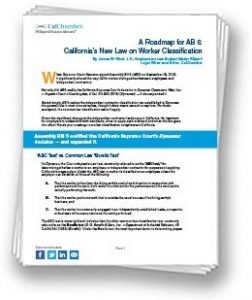
In September, Governor Gavin Newsom signed AB 5 (Gonzalez; D-San Diego) — and significantly altered the way California law distinguishes between employees and independent contractors.
AB 5 did two things: First, it codified the California Supreme Court’s decision in Dynamex Operations West, Inc v. Superior Court of Los Angeles, 4 Cal. 5th 903 (2018) (Dynamex); and second, it expanded this decision so that starting January 1, 2020, it applies to more workers.
What that means as far as employers are concerned is that AB 5 makes the independent contractor classification test established in Dynamex — the ABC test — the general rule in most circumstances.
Under the ABC test, a worker is classified as an employee unless the employer can establish all three of the following:
- The worker is free from the hiring entity’s control and direction in connection with performance of the work, both under the contract for the performance of the work and in actually performing the work;
- The worker performs work that is outside the usual course of the hiring entity’s business; and
- The worker is customarily engaged in an independently established trade, occupation or business of the same nature as the work performed.
The new law does, however, create several exceptions. For those exempted, the common law classification test — also known as the Borello test — will apply. Frequent media discussions about the exceptions might have misled employers into thinking that if an exception applies to them, they may classify their workers in any way they choose. But that is not the case.
The CalChamber’s latest free white paper, A Roadmap for AB 5: California’s New Law on Worker Classification, includes the many exceptions to the ABC test carved out for various occupations and professional services, as well as information on the ABC test versus the common law Borello test, the way AB 5 has expanded the ABC test, the new law’s effective dates, and some final thoughts for California employers.
A webinar, “Independent Contractors — Dynamex, AB 5 and Beyond,” also is available for additional background and context on this sweeping new California law set for January 1, 2020.
CalChamber members can access the white paper here. Not a member? See how CalChamber can help you.


